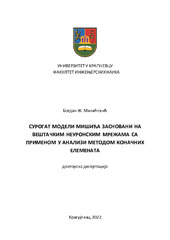Приказ основних података о дисертацији
Surogat modeli mišića zasnovani na veštačkim neuronskim mrežama sa primenom u analizi metodom konačnih elemenata
Surrogate muscle models based on artificial neural networks with applications in finite element analysis
| dc.contributor.advisor | Filipović, Nenad | |
| dc.contributor.other | Milošević, Miljan | |
| dc.contributor.other | Ranković, Vesna | |
| dc.contributor.other | Ivanović, Miloš | |
| dc.contributor.other | Stojanović, Boban | |
| dc.creator | Milićević, Bogdan | |
| dc.date.accessioned | 2023-09-06T12:18:16Z | |
| dc.date.available | 2023-09-06T12:18:16Z | |
| dc.date.issued | 2022 | |
| dc.identifier.uri | http://eteze.kg.ac.rs/application/showtheses?thesesId=8678 | |
| dc.identifier.uri | https://fedorakg.kg.ac.rs/fedora/get/o:1637/bdef:Content/download | |
| dc.identifier.uri | https://nardus.mpn.gov.rs/handle/123456789/21638 | |
| dc.description.abstract | Biofizički modeli mišića, zasnovani na fiziološkim principima funkcionisanja mišića, se mogu koristiti da odrede mehanički odziv mišića preciznije nego fenomenološki modeli, koji su zasnovani na eksperimentalnim merenjima. Međutim, za razliku od fenomenoloških, biofizički modeli mišića su računski veoma zahtevni, što otežava njihovu upotrebu u višeskalnim simulacijama. Tipičan primer biofizičkog modela mišića je Hakslijev model. U ovoj disertaciji, da bi se omogućila efikasnija upotreba biofizičkih modela, kreirani su surogat modeli zasnovani na veštačkim neuronskim mrežama takvi da oni imitiraju originalni Hakslijev model, ali koriste manju količinu memorije i drugih računarskih resursa. Najbolji rezultati su postignuti zatvorenim rekurentnim jedinicama, koje su dale najtačnije napone u mišiću od svih konstruisanih mreža. U različitim numeričkim eksperimentima je pokazano da su predviđeni naponi i trenutna krutost skoro potpuno isti kao originalni. Pokazano je da je konstruisani surogat model za red veličine brži od Hakslijevog modela rešavanog klasičnim numeričkim postupkom i da troši manju količinu memorije. Pored toga, u ovoj disertaciji su prikazane neuronske mreže podržane fizičkim zakonima, koje su obučavane tako da aproksimiraju rešenje Hakslijeve jednačine za mišićnu kontrakciju. Pokazano je da višeslojni perceptron, podržan fizičkim zakonima, bolje generalizuje ponašanje mišića nego standardni višeslojni perceptron. U ovoj disertaciji su predstavljene procedure za kreiranje surogat modela mišića, zajedno sa procedurama za integraciju surogat modela u softverski okvir za analizu metodom konačnih elemenata. Da bi potencijal surogat modela za korišćenje u zahtevnim višeskalnim simulacijama bio demonstriran u punom obimu, simuliran je srčani ciklus leve komore, što bi bilo značajno teže uraditi sa originalnim Hakslijevim modelom. | sr |
| dc.description.abstract | Biophysical muscle models, which are based on the underlying physiology of the muscles, can evaluate the mechanical response of the muscles more accurately than phenomenological muscle models, which are based on experimental measurements. On the other hand, biophysical muscle models are much more computationally intensive. Biophysical muscle models are often called Huxley-type muscle models. In this dissertation, to enable the efficient use of Huxley-type muscle models in multi-scale simulations of the cardiac cycle, surrogate models were created such that they mimic the original Huxley muscle model but use less memory and processing power. The best results were achieved with the gated recurrent units, which produced the most accurate stresses. Stresses and instantaneous stiffnesses produced by the surrogate model were almost indistinguishable from the original values. The constructed surrogate model was an order of magnitude faster than Huxley’s muscle model and used less memory. Additionally, in this dissertation, physics-informed neural networks were trained to approximately solve Huxley’s muscle contraction equation. It was shown that the generalization of the physics-informed multilayer perceptron is greater than that of the ordinary multilayer perceptron. The procedures for the creation of the surrogate muscle models were introduced in this dissertation, along with the procedures for the integration of the surrogate models into a finite element analysis framework. To show the potential of the surrogate models in larger-scale simulations, the cardiac cycle of the left ventricle model was simulated, which would be much higher to do with the original Huxley’s muscle model. | en |
| dc.format | application/pdf | |
| dc.language | sr | |
| dc.publisher | Универзитет у Крагујевцу, Факултет инжењерских наука | sr |
| dc.rights | openAccess | en |
| dc.rights.uri | https://creativecommons.org/licenses/by-sa/4.0/ | |
| dc.source | Универзитет у Крагујевцу | sr |
| dc.subject | veštačke neuronske mreže | sr |
| dc.subject | artificial neural networks | en |
| dc.subject | recurrent neural networks | en |
| dc.subject | physics-informed neural networks | en |
| dc.subject | surrogate models | en |
| dc.subject | Huxley muscle model | en |
| dc.subject | finite element method | en |
| dc.subject | left ventricle model | en |
| dc.subject | rekurentne neuronske mreže | sr |
| dc.subject | neuronske mreže podržane fizičkim zakonima | sr |
| dc.subject | surogat modeli | sr |
| dc.subject | Hakslijev model mišića | sr |
| dc.subject | metod konačnih elemenata | sr |
| dc.subject | model leve komore | sr |
| dc.title | Surogat modeli mišića zasnovani na veštačkim neuronskim mrežama sa primenom u analizi metodom konačnih elemenata | sr |
| dc.title.alternative | Surrogate muscle models based on artificial neural networks with applications in finite element analysis | en |
| dc.type | doctoralThesis | |
| dc.rights.license | BY-SA | |
| dc.identifier.fulltext | http://nardus.mpn.gov.rs/bitstream/id/151896/Disertacija.pdf | |
| dc.identifier.rcub | https://hdl.handle.net/21.15107/rcub_nardus_21638 |


